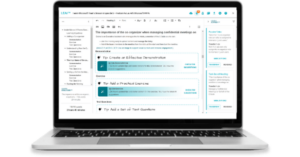It is without a doubt that sales training is a business essential for B2B organizations. In a study by ValueSelling Associates, they found that sales people who said they were likely to miss quota:
- Received moderate-to-low levels of sales training (both on product and skills)
- Lacked the support of a formal sales coaching program
- Lacked formal training on how to communicate value to customers
To avoid the above pitfalls, every organization should invest in building a great program that empowers sales reps, increases productivity, better engages with customers, increases conversions and boosts company revenues. But what are the components of a good program? In this blog post, we provide some ideas on benefits you can expect from a good training program, who should be included in your sales training programs, what subjects to include, and how to structure your training content for maximum effectiveness.
Sales training benefits
Sales training vs sales enablement
Knowing which sales training content to include
Training for product knowledge
Structuring your sales training
Best practices
How to measure training effectiveness
Creating training content With LEAi
Sales training benefits
Training your sales team impacts both individual performance and the company overall. The CPSA states that sales training allows teams to better integrate best practices in sales performance, gain more in-depth knowledge (and confidence) about their product offering, improve employee retention, develop more accurate forecasting and realistic goals and close more deals. Other organizations, when asked how to measure effectiveness, reported:
- Increased productivity,
- Improved employee communication,
- Encouraged greater creativity,
- Provided higher resilience during downturns,
- Enabled deeper relationships with clients,
- Improved customer buying experience,
- Encouraged more customer loyalty,
- Improved ability to attract top talent,
- Encouraged more innovative thinking
- Emphasized best practices.
In terms of ROI, an internal study at Motorola identified a return of investment of $29 for each dollar invested in sales training. Another recent industry report found that 87 percent of sales leaders who said they received “adequate” management training, reported that an average of 75 percent of their reps achieved quota in the previous year. This suggests that even a little training can have significant effects.
Sales training vs sales enablement
Often used interchangeably, there is a distinction between sales training and sales enablement. In general, sales training is the information and skills that sales reps need to close more and better deals. Typically, this includes product knowledge to sell your company’s products or services including technical specifications, product use cases, service level agreements, warranties and more.
Sales training will also include a company’s sales process such as sales strategies, and skills salespeople need to use as they interact with prospects. This ensures sales are handled appropriately and in line with your company’s values and brand.
Sales enablement is greater than sales training and it is not necessarily just for sales. It’s a strategic approach where the entire organization is involved in the process of enhancing sales performance. In addition to product training and sales process training, this may include items such as sales coaching, onboarding, marketing and learning content creation, process improvements, and more.
When designing your training program, consider expanding those who receive the training to all those who enable your sales and business development teams. Sales reps rely on the entire organization to close the deals and empowering your sales enablement teams with skills and product knowledge will help to create a more robust and effective sales organization.
Knowing which sales training content to include
Google “topics for sales training” and you will receive over 3 billion search results. There are a lot of topics to cover when considering how to create a program that is right for your organization. However, here are 10 common topics that every organization should consider including in their programs:
Selling strategies – These can vary by product, service, industry, geography and persona. Some benefit from a more traditional approach to selling while others need innovative ways to reach potential clients and get to a closed deal.
Product knowledge training– This equips your sales reps with the information and confidence to answer customer questions. A good (and consistent) product knowledge training program also ensures that prospects receive a consistent message and experience.
Buyer personas training– Providing training based on the prospect’s position and influence enables sales reps to understand the customer’s buying mentality and gain insights into their pain points and buying cues.
Competitive Analysis – This involves both looking at differences in products and corporate services. Having a clear understanding of what your competitors do, can help you and your sales reps to clearly articulate your unique value proposition and strengths. It also enables you to build messaging to address any brand weaknesses.
Sales negotiation – A subtle art that requires understanding clients’ motivation and pain points, teaching sales about negotiations includes teaching how to control the flow of information, how to create “negotiating space”, and how to time concessions.
Deal closing –There comes a time in the sales cycle when the rep needs to make a move and seal the deal. Provide training on how to nurture the relationship with buyers, overcome obstacles, recognize buying signals, and ask for the business.
Effective communication – Teaching sales on the right balance between talking and listening helps to keep customers engaged
Time management – From prospecting to keeping existing clients engaged, there are a lot of things for sales reps to do. Providing effective strategies (and tools) to reduce wasted time is always a worthwhile investment.
Customer success – For SaaS companies, customer success is just as important as the initial sale. Sales reps need to know how to cross-sell, up-sell, reduce churn and ensure renewals.
Sales leadership – Nurture your high-performing sales reps who have the potential to lead large sales team with training on how to establish clear goals, set expectations, delegate, give feedback, and coach/mentor employees.
When deciding the courses to include in your program, consider what are the goals, how they may differ for different sales teams, different experience levels and different positions.
To increase retention and effectiveness, companies should design their sales programs to offer training options that reinforce what they’ve already learned and provide opportunities to practice their skills when they need it.
How to use sales enablement to boost your product marketing strategy
Training for product knowledge
Let’s dig a little deeper on topic #5 from the above list. Aside from soft sales skills, a training program for sales teams should include lots of product knowledge so that they know:
How to use the product: Sales should know how the product works and be able to demo the product in action. Case studies, examples and scenario-based exercises are a great way to support this type of training.
Price/ROI: Aside from the price packages, sales reps must know and articulate the return on investment and value a product can bring.
Product and customer support resources: Sales reps should know what resources are available to them and their clients when they have a question. This includes what type of documentation is available, in and out of the product, and where it is stored, where knowledge-base articles are located, and what kind of training is available for the product.
Product roadmap: Sales needs to know what features are coming and when, to help them seal the deal.
Structuring your training
According to an article in the Harvard Business Review participants in traditional curriculum-based training forget more than 80 percent of the information they were taught within 90 days. This statistic is not surprising if you consider how sales training is often conducted.
Organizations typically convey large amounts of information when onboarding a new salesperson, when new products are introduced or during annual “sales kick-off” meetings when the sales direction and quotas are discussed. To increase retention and effectiveness, companies should design their sales programs to offer training options that reinforce what they’ve already learned and provide opportunities to practice their skills when they need it.
For these reasons, sales programs should be structured so they frequently offer a good mixture of Instructor led training, eLearning, microlearning, coaching and mentoring that increase both skills and product knowledge.
Skills Training: When it comes to sales skills training, there many options available. Many organizations, such as Dale Carnegie, offer both in-person and online training sessions. HubSpot has compiled a list of “36 Best Sales Training Courses for Every Budget and Team” that is worth checking out. If you are looking for free training that your sales team can take on an adhoc basis, HubSpot has also compiled a list of videos on YouTube.
Product Training Development and Structure: When it comes to product training, this is typically handled by internal documentation or learning and development teams and there are many challenges that prevent an organization from creating effective product training content for sales teams.There are many evolutions in training tools and best practices that can solve some of these problems. These include:
- Adopting rapid course development methodologies to ensure that training content keeps pace with the new product features
- Introducing microlearning that focuses on training small learning topics that are easier to develop and can increase student autonomy and retention
- Opting for blended learning modes including webinars, online learning and instructor led training (ILT) that can be more cost-effective, engaging and effective
10 Tips for delivering effective product training to sales teams
Best practices
When it comes to sales training, there are several best practices to maximize engagement and effectiveness.
- Focus on specific learning goals: Clearly define what you want your sales team to master. Set specific, measurable, achievable, relevant, and time-bound (SMART) goals to guide the training process.
- Tailor the training: Assess the current skill levels and knowledge gaps and customize the training content and delivery methods to address those specific needs.
- Provide a blended learning approach: Incorporate a mix of training methods and modalities, such as classroom sessions, online courses, role-playing exercises, workshops, and mentorship programs. This helps cater to different learning styles and ensures a comprehensive learning experience.
- Teach soft-skills too: Don’t just teach about the company’s product and services. Include training that strengthens essential skills like communication, critical thinking, emotional intelligence, and productivity.
- Make it interactive and practical: Encourage active participation with role-playing, hands-on exercises, case studies, simulations, and real-life scenarios.
- Add an element of competition: Most sales teams are inherently fun (and competitive). Add a game-like experience by incorporating elements such as points, levels, badges, leaderboards, and rewards.
How to measure training effectiveness
Measuring the effectiveness of sales training is essential to determine its impact on the performance and success of sales teams. Here are several key methods to measure the effectiveness of sales training:
- Performance Metrics: Compare key performance indicators (KPIs) before and after the training to assess its impact on sales results. Some relevant metrics include conversion rates, revenue generated, average deal size, sales cycle length, and customer satisfaction ratings.
- Sales Quotas: Analyze whether sales representatives meet or exceed their sales quotas after the training. This indicates the effectiveness of the training in improving sales performance.
- Skill Assessments: Conduct pre-training and post-training assessments to evaluate the improvement in specific sales skills and knowledge areas targeted by the training. These assessments can include role-playing exercises, quizzes, or simulations.
- Surveys and Feedback: Collect feedback from sales team members through surveys or interviews to gauge their perception of the training’s effectiveness. Ask about their confidence in applying the learned skills, the relevance of the training content, and their overall satisfaction.
- Manager Observations: Encourage sales managers to closely observe their team’s performance and behavior following the training. They can provide insights into whether the training has positively impacted sales strategies, communication techniques, and overall productivity.
- Sales Team Engagement: Measure the level of engagement and participation during the training sessions. Higher engagement indicates a more effective training program. Monitor attendance, completion rates, and the extent to which participants actively contribute and apply the learned concepts.
- Sales Team Retention: Assess whether the training has contributed to improved employee retention rates. Satisfied and well-trained salespeople are more likely to stay with the organization, reducing turnover costs and maintaining a stable, skilled salesforce.
- Post-Training Follow-up: Conduct follow-up sessions or assessments after a certain period to evaluate the long-term retention and application of the training content. This helps determine whether the training has a lasting impact on sales performance.
Remember that measuring the effectiveness of sales training should be an ongoing process, rather than a one-time event. By combining multiple methods and collecting data over time, you can gain a comprehensive understanding of the training’s impact and make informed decisions about its improvement or future iterations.
5 Ways to measure ROI of your sales training program
Creating training content with LEAi

For these reasons, we developed LEAi, which is an AI-enabled tool that allows those responsible for learning and development (L&D) to create content for instructor led training (ILT), eLearning, knowledge base articles, virtual class content, presentations, webinars and videos using content your subject matter experts have already created.
You don’t have to be a L&D specialist to use LEAi. Our tool is so easy to use that everyone from HR to sales enablement can convert existing content they have into learning content that follow best practices – in minutes. Key benefits of LEAi include:
- Use content that exists
- Be guided by best practices
- Update existing courses fast
- Repurpose content easily
- Use the content to create different learning delivery modes
If you are considering creating or updating your sales training program and you need a tool to help you accelerate the creation of internal training, drop us a note!




